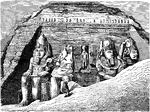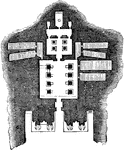Clipart tagged: ‘rock temple’

Rock Temple at Abu-Simbel
"The temple, built by Ramses II on the steep face of a cliff overlooking the Nile, has a facade containing…

Interior of Indra Sabha at Ellora
Jain caves reveal specific dimensions of Jain philosophy and tradition. They reflect a strict sense…

Cross Section of the Great Temple at Abu Simbel
In most rock-temples a court, which is sometimes hewn out of the rock, or a covered vestibule forms…

Entrance to the Great Temple at Abu Simbel
In 1959 an international donations campaign to save the monuments of Nubia began: the southernmost relics…

Entrance of the Great Temple at Abu Simbel
Four colossal 20 meter statues of the pharaoh with the double crown of Upper and Lower Egypt decorate…

Floor Plan of the Great Temple at Abu Simbel
In most rock-temples a court, which is sometimes hewn out of the rock, or a covered vestibule forms…

Hall Section of the Great Temple at Abu Simbel
This image shows how the middle passage is made more imposing by the arrangement of elevating the columns…